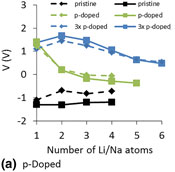Crossref Citations
This article has been cited by the following publications. This list is generated based on data provided by
Crossref.
Kulish, Vadym
Koch, Daniel
and
Manzhos, Sergei
2017.
Insertion of Mono- vs. Bi- vs. Trivalent Atoms in Prospective Active Electrode Materials for Electrochemical Batteries: An ab Initio Perspective.
Energies,
Vol. 10,
Issue. 12,
p.
2061.
Chen, Yingqian
Lüder, Johann
Ng, Man-Fai
Sullivan, Michael
and
Manzhos, Sergei
2018.
Polyaniline and CN-functionalized polyaniline as organic cathodes for lithium and sodium ion batteries: a combined molecular dynamics and density functional tight binding study in solid state.
Physical Chemistry Chemical Physics,
Vol. 20,
Issue. 1,
p.
232.
Koch, D
Golub, P
and
Manzhos, S
2018.
Stability of charges in titanium compounds and charge transfer to oxygen in titanium dioxide.
Journal of Physics: Conference Series,
Vol. 1136,
Issue. ,
p.
012017.
Kulish, Vadym
Liu, Wenyuan
Benistant, Francis
and
Manzhos, Sergei
2018.
Dopant–dopant interactions in beryllium doped indium gallium arsenide: An ab initio study.
Journal of Materials Research,
Vol. 33,
Issue. 4,
p.
401.
Manzhos, Sergei
2019.
Organic electrode materials for lithium and post-lithium batteries: an ab initio perspective on design.
Current Opinion in Green and Sustainable Chemistry,
Vol. 17,
Issue. ,
p.
8.
Chen, Yingqian
Cho, Chae-Ryong
and
Manzhos, Sergei
2019.
Lithium Attachment to C60 and Nitrogen- and Boron-Doped C60: A Mechanistic Study.
Materials,
Vol. 12,
Issue. 13,
p.
2136.
Heiska, Juho
Nisula, Mikko
and
Karppinen, Maarit
2019.
Organic electrode materials with solid-state battery technology.
Journal of Materials Chemistry A,
Vol. 7,
Issue. 32,
p.
18735.
Roselin, L. Selva
Juang, Ruey-Shin
Hsieh, Chien-Te
Sagadevan, Suresh
Umar, Ahmad
Selvin, Rosilda
and
Hegazy, Hosameldin H.
2019.
Recent Advances and Perspectives of Carbon-Based Nanostructures as Anode Materials for Li-ion Batteries.
Materials,
Vol. 12,
Issue. 8,
p.
1229.
Mauger, Alain
Julien, Christian
Paolella, Andrea
Armand, Michel
and
Zaghib, Karim
2019.
Recent Progress on Organic Electrodes Materials for Rechargeable Batteries and Supercapacitors.
Materials,
Vol. 12,
Issue. 11,
p.
1770.
Zhu, Jiakun
Guo, Mohan
Liu, Yuemei
Shi, Xiaobo
Fan, Feifei
Gu, Meng
and
Yang, Hui
2019.
In Situ TEM of Phosphorus-Dopant-Induced Nanopore Formation in Delithiated Silicon Nanowires.
ACS Applied Materials & Interfaces,
Vol. 11,
Issue. 19,
p.
17313.
Qing, Huilin
Wang, Ruirui
Chen, Ziliang
Li, Mingming
Zhang, Lilei
Zhou, Yong-Ning
and
Wu, Renbing
2020.
In-situ embedding cobalt-doped copper sulfide within ultrathin carbon nanosheets for superior lithium storage performance.
Journal of Colloid and Interface Science,
Vol. 566,
Issue. ,
p.
1.
Olsson, Emilia
Hussain, Tanveer
Karton, Amir
and
Cai, Qiong
2020.
The adsorption and migration behavior of divalent metals (Mg, Ca, and Zn) on pristine and defective graphene.
Carbon,
Vol. 163,
Issue. ,
p.
276.
Heiska, Juho
Nisula, Mikko
Rautama, Eeva-Leena
Karttunen, Antti J.
and
Karppinen, Maarit
2020.
Atomic/molecular layer deposition and electrochemical performance of dilithium 2-aminoterephthalate.
Dalton Transactions,
Vol. 49,
Issue. 5,
p.
1591.
Lüder, Johann
and
Manzhos, Sergei
2020.
First-Principle Insights Into Molecular Design for High-Voltage Organic Electrode Materials for Mg Based Batteries.
Frontiers in Chemistry,
Vol. 8,
Issue. ,
Koch, Daniel
and
Manzhos, Sergei
2020.
Ab initiomodeling and design of vanadia-based electrode materials for post-lithium batteries.
Journal of Physics D: Applied Physics,
Vol. 53,
Issue. 8,
p.
083001.
Manzhos, Sergei
2020.
Aggregate-State Effects in the Atomistic Modeling of Organic Materials for Electrochemical Energy Conversion and Storage Devices: A Perspective.
Molecules,
Vol. 25,
Issue. 9,
p.
2233.
Wang, Tongde
Li, Qian
Feng, Quantao
Miao, Yidong
Li, Tianlin
Qi, Jiqiu
Wei, Fuxiang
Meng, Qingkun
Ren, Yaojian
Xiao, Bin
Xue, Xiaolan
Sui, Yanwei
and
Sun, Zhi
2021.
Carbon defects applied to potassium-ion batteries: a density functional theory investigation.
Nanoscale,
Vol. 13,
Issue. 32,
p.
13719.
Koch, Daniel
and
Manzhos, Sergei
2021.
Can doping of transition metal oxide cathode materials increase achievable voltages with multivalent metals?.
International Journal of Quantum Chemistry,
Vol. 121,
Issue. 2,
Wang, Binghao
Scaccabarozzi, Alberto D.
Wang, Haoyang
Koizumi, Mari
Nugraha, Mohamad Insan
Lin, Yuanbao
Firdaus, Yuliar
Wang, Yan
Lee, Sunghoon
Yokota, Tomoyuki
Anthopoulos, Thomas D.
and
Someya, Takao
2021.
Molecular doping of near-infrared organic photodetectors for photoplethysmogram sensors.
Journal of Materials Chemistry C,
Vol. 9,
Issue. 9,
p.
3129.
Puttaswamy, Rangaswamy
Nagaraj, Radha
Kulkarni, Pranav
Beere, Hemanth Kumar
Upadhyay, Shrish Nath
Balakrishna, R. Geetha
Sanna Kotrappanavar, Nataraj
Pakhira, Srimanta
and
Ghosh, Debasis
2021.
Constructing a High-Performance Aqueous Rechargeable Zinc-Ion Battery Cathode with Self-Assembled Mat-like Packing of Intertwined Ag(I) Pre-Inserted V3O7·H2O Microbelts with Reduced Graphene Oxide Core.
ACS Sustainable Chemistry & Engineering,
Vol. 9,
Issue. 11,
p.
3985.



